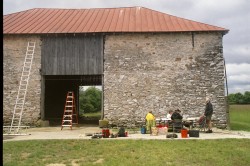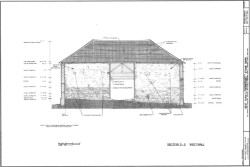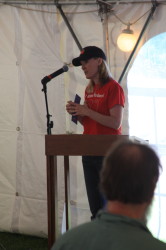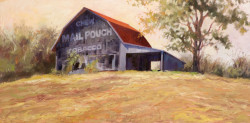This guest post by Raina Regan, a preservationist working hard to bring attention to barn preservation at Indiana Landmarks, the statewide “nonprofit organization, fighting to defend architecturally unique, historically significant, and communally cherished properties…” in Indiana. NBA is thrilled to see the dedication of those barn-loving Hoosiers! This Barn Again! workshop is not a new thing for Indiana Landmarks and they sure know how to do it right – don’t miss out on this great event.
Although located directly east of metropolitan Indianapolis, Hancock County, Indiana is rich in agricultural heritage. Driving county roads, you’ll find timber frame barns and steel silos dotting the slightly rolling landscape. This fall, don’t miss Indiana Landmarks’ BARN AGAIN! workshop in Hancock County to explore this historic community while learning about barn preservation.
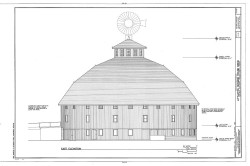 This day long workshop on September 19 will provide practical solutions from experts on how to maintain, rehabilitate, and adapt old barns for today’s needs. Participants will learn about the history and technology of barns as well as barn maintenance, adaptive reuse, and preservation. Rick Collins of Trillium Dell Timberworks will headline our workshop speakers. The workshop will also highlight a new Indiana law which offers a 100 percent property tax deduction for heritage barns not used for farming or business purposes.
This day long workshop on September 19 will provide practical solutions from experts on how to maintain, rehabilitate, and adapt old barns for today’s needs. Participants will learn about the history and technology of barns as well as barn maintenance, adaptive reuse, and preservation. Rick Collins of Trillium Dell Timberworks will headline our workshop speakers. The workshop will also highlight a new Indiana law which offers a 100 percent property tax deduction for heritage barns not used for farming or business purposes.
The afternoon will include a tour of four barns in northern Hancock County, providing an opportunity to learn about the design, history, and rehabilitation of historic barns. The tour includes a stop at the award-winning, National Register-listed Frank Littleton Round Barn. The Littleton Round Barn dates from 1903 and is an impressive true circular barn with a 102’ diameter. The barn was commissioned by Indianapolis attorney Frank Littleton, who called upon Benton Steele for the design. Steele had recently built the largest round barn in the state, a 100’ diameter round barn for Littleton’s rival, Congressman Wymond L. Beckett. As the story is told, Littleton had Steele build his barn just a little bit larger, for a total of 102 feet in diameter, so that he could beat out his rival. Constructed by Issac McNamee and Horace Duncan, the Littleton Round Barn still holds the title for largest round barn in the state of Indiana. We’re excited to include the property on our barn tour to highlight this impressive structure which continues to function in an agricultural use.
Other barns on the tour include a depression-era Dairy Barn and an unusual transverse frame basement barn – featuring rusticated concrete blocks cast on site. Our fourth barn is a 19th century timber frame barn, which sits on an early Hancock County farm dating from the 1830s. The tour promises to highlight a wide variety of historic barn types, perfect for anyone passionate about agricultural heritage.
The BARN AGAIN! workshop will be held at NineStar Connect Conference Center, 2243 East Main Street, Greenfield, IN 46140. Cost for the day-long workshop is $45 and includes lectures, lunch, an informational packet, and the barn tour. There is a discounted price for members of Indiana Landmarks. The reservation deadline for the BARN AGAIN! workshop is September 15. Register online at barnagain2014.eventbrite.com or contact Indiana Landmarks at 800-450-4534. Questions? Contact Raina Regan, Community Preservation Specialist, 317-639-4534, rregan@indianalandmarks.org.

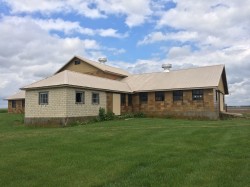
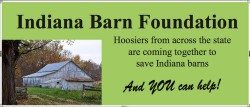 A passionate and motivated group of Hooisers have been working hard to establish a barn organization for the state of Indiana in recent months – and what great success they have had in such a short period of time. The first annual meeting of the Indiana Barn Foundation is coming up on July 12th and the group can already boast of supporting barn preservation legislation! Last month, members of the organization were
A passionate and motivated group of Hooisers have been working hard to establish a barn organization for the state of Indiana in recent months – and what great success they have had in such a short period of time. The first annual meeting of the Indiana Barn Foundation is coming up on July 12th and the group can already boast of supporting barn preservation legislation! Last month, members of the organization were 